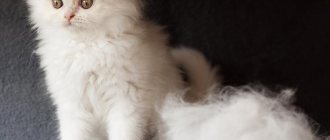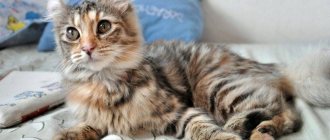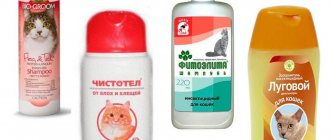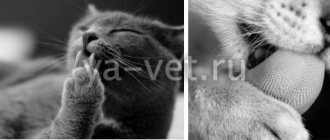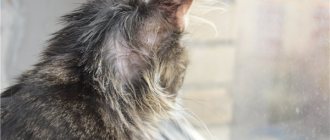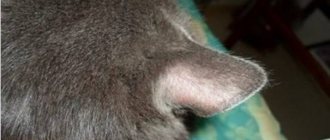History of the origin of the British cat
Judging by the name itself, it becomes clear that the homeland of these cats is Great Britain. Historians suggest that these animals were brought to the British Isles by the ancient Romans around the first century AD.
The main advantage of those ancient representatives of the British was their short and very dense coat, which provided the animals with protection from moisture and harmful insects. It was thanks to this wool that the British quickly got used to and adapted to new living conditions.
They were excellent hunters, thanks to their high levels of endurance and well-developed physical fitness.
Due to their spectacular appearance, at the end of the 16th century, British felines began to be looked at not only as skilled hunters. And already in 1871, British individuals participated in the first cat exhibition in London.
British cat fur care
Even if British cats are not the type that can torture you with a huge amount of hair, it should be noted that there are problems with it too. If you are not going to perform special care, the cat will look very bad, but good grooming is the key to the chic appearance of your four-legged friend. Don't be afraid to do this at home - you don't need anything special to care for the coat.
Combing wool
In the event that you are going to master combing a British cat, remember that the procedure is definitely necessary if you want to save the cat from the consequences of shedding, and also not to get a large amount of hair on furniture and clothes. This is much easier to do than many people think, so remember that you need to brush your cat regularly, but not for long. There is no need to torture your cat for 30 minutes once a month - do it every day, but for 2-3 minutes and you will notice an excellent result. In addition, cats' fur gets dirty a lot, and brushing will be a great help.
In addition, if you do not remove excess hair, the cat will swallow it when washing. Non-pedigreed cats, especially British ones, are good at coughing up hair, which can cause health problems. In general, British cats are characterized by problems with ingesting fur, especially during the molting period. Sometimes this is nothing special - the cat copes on its own, but sometimes problems arise. It is necessary to comb from the head, past the belly and towards the tail. The belly should be brushed last. In addition, you do not need to move the brush against hair growth. From this you will get a visually more massive result, but you can forget about the smoothness of the coat. You can also wipe the cat with a damp cloth, they enjoy it.
It will be very good if the cat really likes the procedure; this does not always happen, but a lot will also depend on your efforts. For example, you can use not just a comb that comes to hand, but also normal tools:
1. one brush with stiff bristles;
2. a brush with soft bristles;
3. a toothbrush that is perfect for the cat’s face;
4. dry shampoo is ideal for cleaning wool - buy one tube to try it out;
5. a separate towel and a small cloth for the cat.
Washing a cat
In any case, we will not wash the cat often, because this should be done only when it gets dirty. There are also not a particularly large number of rules here, so you can easily cope with this procedure without causing any serious problems for the cat. For example, you can place a rag on the bottom of the bathtub or basin in which bathing will take place. When the cat feels something soft, it will calm down a little or completely. In addition, the water should not rise above the level of the cat’s stomach so that she does not panic. Let us immediately note that some cats are so afraid of bathing that they begin to think that they are trying to drown them or something like that. You don’t need to think that repeated bathing by force will necessarily improve the situation - usually it only gets worse, so you will need dry shampoos and more often use a special rag to wash the fur.
The water pressure should be weak so that there is no noise and unnecessary impact on the cat, there is no need to wet the head, water should not get on the face and ears. It would be nice if the final step is to apply conditioner, which will refresh the cat. Even if the room temperature is significantly higher than +24 degrees, you will need to thoroughly dry your shaggy friend so that he experiences as little discomfort as possible.
Drying a cat
It’s best to dry your cat with a towel, but if your shaggy friend doesn’t mind, you can even use a hairdryer for this purpose, but the main thing is to act carefully and watch the cat’s reaction. She may sit quietly, but this does not mean that everything is fine - it may be something like paralysis from fear, which will pass when you turn off the hair dryer. In any case, keep a close eye on the cat and everything will go fine.
Dry cleaning
If it is simply impossible to wash the cat, there is no need to be afraid and there is no need to blame the cat for this either - the dry cleaning procedure will help us out. She has never been anything complicated; we will need dry shampoo, as well as a little patience and attentiveness. A distinctive feature of dry shampoo is that it does not require pre-wetting the coat, does not require rinsing and similar procedures. We need to apply shampoo to the cat's fur, rub it in thoroughly, as if we were bathing in the bath, and after some time, which is indicated in the instructions, it will be necessary to comb the cat. Then you will have to comb out the shampoo quite carefully and for a long time, because the cat can be poisoned by it, but now the manufacturers have thought about this, so now the combing procedure is not difficult.
Conclusion
If you see fur on clothes or furniture from a British cat a couple of times, don’t think that you were given a fake - this is an excellent breed of cat that just sometimes needs help too. Using a wet or dry wash, you can rid the coat of dirt and comb out loose hair, which will go quickly, but will give an excellent result. There are no secrets or subtleties in this procedure; all detailed instructions, if you don’t understand something, can be found on the Internet, where everything is organized into really very convenient guides. The cost of dry shampoo and various brushes has also never been high, so all this can be purchased in the required volume and quite quickly.
Description of the breed
The main characteristic feature of the British is power, especially when it comes to males. Female cats are smaller in size than male cats. Squat height and rather large size, developed muscles and sternum - this is the image of a modern Briton.
The head of these cats is large with rounded outlines. The muzzle has developed cheeks and cheekbones. Only the British have a pronounced fold of skin around the neck.
The nose is medium long, rather wide. When viewed in profile, you can see that the nose forms a depression in the frontal part. The ears are located quite widely, with a wide base. The shape is rounded, the size of the ears is medium.
British people have large, round eyes. Set wide apart. What distinguishes British cats is the color of their eyes, characteristic of the breed - it is bright orange.
Newborns may have blue eyes, however, over time they will change their color. It is very rare to come across cats with blue or green eyes.
Medium or short llamas are equipped with well-developed strong muscles. The tail is of medium length and looks proportional to the body.
Appearance of a British cat
In general, this is a powerful, muscular, compact animal with a harmonious build and quite large size. Cats are smaller and more graceful compared to cats.
Body
According to the physique, British cats are classified as cobby-type:
- the skeleton is strong, stocky;
- the neck is short and strong;
- the chest is wide, developed;
- the shoulders are massive, the same width as the body;
- the back is short, straight;
- limbs of medium length or short, dense, ending in rounded strong paws with closed toes;
- the tail is of medium length, wide at the base, tapering to a rounded tip.
Head
The closest attention of experts is always directed to the cat's head. It is here that you are most likely to see the shortcomings and defects inherent in the breed. Equally, the standards define the shape of the head as round when viewed from any angle, wide at the cheekbones, massive, with clearly defined outlines.
The British are also characterized by:
- the forehead is convex, with a small flat area between the ears;
- the nose is short, straight, at the level of the back with a change in direction;
- cheeks are full, vibrissae pads are large and round;
- the chin is strong, in profile projection continuing a vertical line from the tip of the nose.
Eyes
Large, round, open, wide-set eyes emphasize the shape of the nose and quite often have a tapering outer corner directed towards the ears. The natural color begins to appear at the age of 4-5 months, is finally formed by one year and depends on the color of the coat. Saturation may vary, but intense shades are preferred.
This is interesting! White cats have the largest number of options: from blue to all shades of gold and copper. In addition, there are white cats and particolors with different eye colors, “odd-Eyed”.
Emerald green eye color is found in silver chinchillas and cats of golden and silver shaded colors . Colorpoints have blue eyes. All other colors are characterized by amber eye color, with a gradation of shades from lemon to copper.
Ears
With minor differences in assessment by the standards of different felinological organizations, in general, the ears of a British cat are defined as short - their height should not exceed the width at the base. The rounded tips and wide set (the distance between the ears is greater than the width of the base) support the overall impression of roundness characteristic of the head.
Wool
The greatest variety differs in the standards for describing the characteristics of the breed's coat. While opinions on the thickness and density of the coat are unanimous, the length requirements vary: for example, GCCF calls it “very short,” and “longer than other short-haired breeds” according to TICA.
Typical British - with short, thick, shiny, dense, like plush hair. At the same time, the double texture that occurs when the length of the guard hair and the undercoat are equal is undesirable.
Colors
The variety of colors allowed by the standards is amazing: over 60 types are distinguished. Including recognized British cats:
- lilac;
- snow white;
- coal black;
- red;
- smoky;
- chocolate;
- silver chinchillas;
- cream;
- marble;
- golden;
- silver;
- ticked (with zonally colored hairs);
- colorpoint (Himalayan);
- particolor;
- tortoiseshells;
- tabby (with its subspecies mackerel, spotted, marbled);
- faun;
- cinnamon.
But still, according to experts, the classic blue coat color remains the most advantageous for cats of the British breed.
Return to content
Animal mating
Representatives of this breed belong to individuals with a late indicator of the development of reproductive systems.
Therefore, knitting a cat in its first year of life is strictly prohibited, because the animal may simply die. The body completes full development only by the age of 6 years.
Early mating of males before 2 years of age can lead to exhaustion, so in the future they will not be able to produce offspring.
British kittens are born completely similar to adults. Physiological features in the form of a disproportionate body are the norm for kittens. Over time, everything will return to normal, and the kitten will take on the appearance of a standard British cat.
Oriental cat - history of the breed, modern standards, character, care, nutrition + 83 photos- Maine Coon - history of occurrence, description of the breed, character + 84 photos
- Burma - a cat as a mascot, hygiene and health, character of the breed + 96 photos
Types of drawings
Tabby is not one specific pattern, as many people believe. There are several varieties of it, and all are considered standard. The pattern appears due to the A gene (agutti). A British female with the color formula “AA” gives birth to only patterned kittens, and with “Aa” the ratio of patterned kittens to plain ones is 50%. Cats with the formula “aa” will be monochromatic.
There are four main types of tabby patterns: ticked, striped, marbled, spotted.
Ticked (Abyssinian)
At first glance, it may seem that the British ticked coat is a solid color, but this is not the case. The color of their coat is not at all uniform: the whole body has barely noticeable stripes, spots or specks (there are “freckles”), slightly darker than the main tone of the British. The tip of the tail is usually dark. Eyes are golden or green.
Striped, brindle (mackerel)
The British tabby cat is the most popular cat available. The second name appeared due to the similarity with the color of the mackerel fish. The pattern is characterized by frequent narrow, clear stripes throughout the body, especially along the ridge. British tabbys are characterized by necklace-like lines on the chest and a broken stripe on the forehead, reminiscent of the Russian letter “M”. The British cat's full brindle coloration develops by the age of one year.
Classic (marble)
One of the most favorite colors among breeders of this breed is the marbled tabby. It is visible already from the birth of the kitten, it may merge slightly, but by two months it has a clear pattern. The body is covered with wide ornate patterns with clear outlines on the back, sides and vague ones on the abdomen and paws. The color of the pattern contrasts with the main shade of the Briton’s body – a kind of marble on silver.
Spotted (leopard)
A cat of the British breed with this coloring is similar to a representative of the wild - a leopard, but in miniature. Wide stripes are intermittent and represent spots of various sizes. Eye color: copper, green.
Character of the breed
The description of the character of the British cat says that these animals are suitable for people who spend little time within the walls of the house. These felines can cope just fine without human attention.
The British have a calm, aristocratic disposition. Even from the photo of a British cat it is clear that they know their worth and have a sense of unsurpassed dignity.
Along with this, they are very friendly and not aggressive. If they are often offended, they become withdrawn and unsociable.
If there is a child in the house, then such a cat will not be suitable for him as a fluffy toy. Otherwise, she will simply hide. British individuals get along well with other animals.

